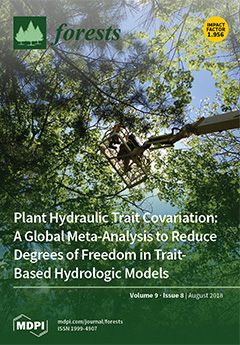Forest-related statistics, including forest biomass, carbon sink, and the prevention of forest fires, can be obtained by estimating stand density. In this study, a dataset with the laser pulse density of 225.5 pulses/m
2 was obtained using airborne laser scanning in a tropical
[...] Read more.
Forest-related statistics, including forest biomass, carbon sink, and the prevention of forest fires, can be obtained by estimating stand density. In this study, a dataset with the laser pulse density of 225.5 pulses/m
2 was obtained using airborne laser scanning in a tropical broadleaf forest. Three digital surface models (DSMs) were generated using first-echo, last-echo, and highest first-echo data. Three canopy height models (CHMs) were obtained by deducting the digital elevation model from the three DSMs. The cell sizes (Csizes) of the CHMs were 1, 0.5, and 0.2 m. In addition, stand density was estimated using CHM data and following the local maximum method. The stand density of 35 sample regions was acquired via in-situ measurement. The results indicated that the root-mean-square error (
) ranged between 1.68 and 2.43; the
difference was only 0.78, indicating that stand density was effectively estimated in both cases. Furthermore, regression models were used to correct the error in stand density estimations; the
after correction was called
. A comparison of the
and
showed that the average value decreased from 12.35 to 2.66, meaning that the regression model could effectively reduce the error. Finally, a comparison of the effects of different laser pulse densities on the
value showed that, in order to obtain the minimum
for stand density, the laser pulse density must be greater than 10, 30, and 125 pulses/m
2 at Csizes of 1, 0.5, and 0.2 m, respectively.
Full article





